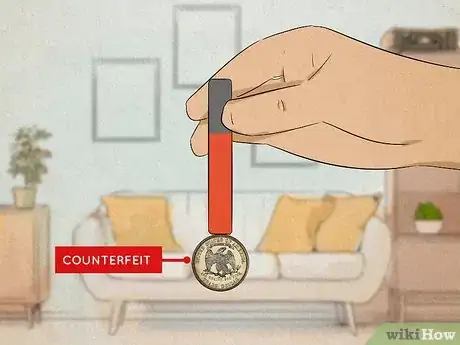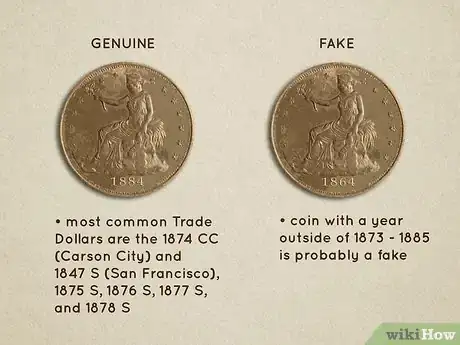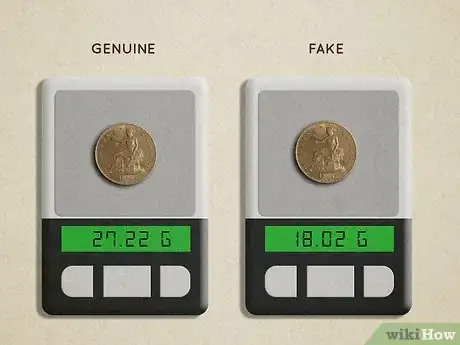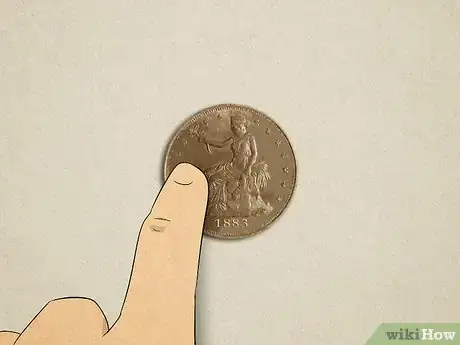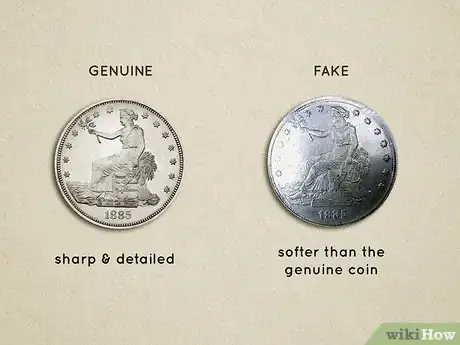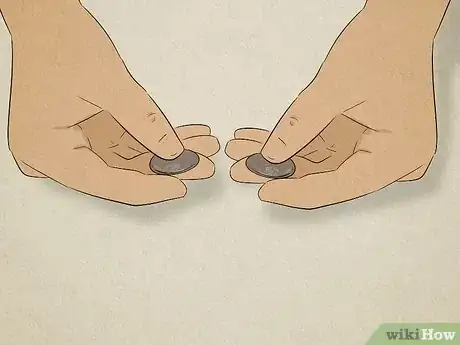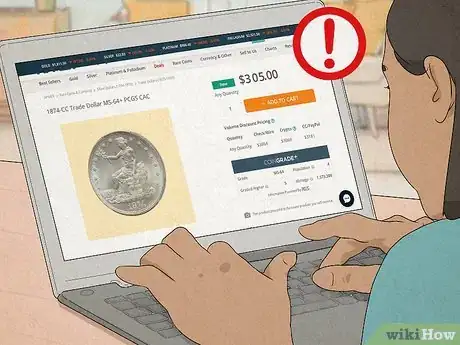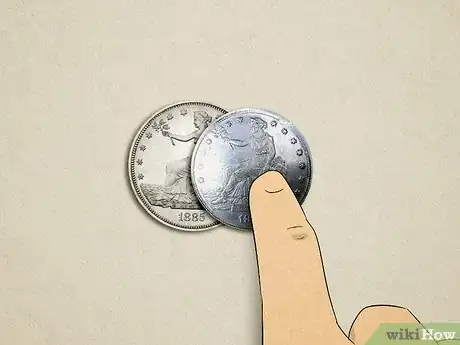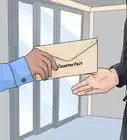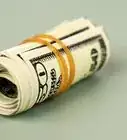wikiHow is a “wiki,” similar to Wikipedia, which means that many of our articles are co-written by multiple authors. To create this article, 10 people, some anonymous, worked to edit and improve it over time.
There are 9 references cited in this article, which can be found at the bottom of the page.
This article has been viewed 108,938 times.
Learn more...
Counterfeit Trade Dollars have pretty much flooded the market over the past decade. If you want to make sure you buy a real coin, the surest route is to buy a Trade Dollar that's been authenticated and graded by PCGS, NGC, or another recognized service. If you're considering a raw—or uncertified—coin, however, there are almost always tells that will give away the difference between a real coin and a counterfeit one. We've rounded up some common giveaways that will help you spot a forgery!
Steps
Try to pick up the coin with a magnet.
-
If the magnet sticks, the coin is a counterfeit. This is a simple test that will tell you right away if a Trade Dollar is real or not. The Trade Dollar is a silver coin, and silver coins are not magnetic, so it definitely shouldn't stick to a magnet.[1] X Research source
- Some coins will stick to magnets, but not silver Trade Dollars.
Check the date on the coin.
-
Trade Dollars were produced between 1873 and 1885. If your coin has a year outside of that range—like 1790—it's probably a fake.[2] X Research source Be very wary of coins dated 1884 or 1885, though—only 10 U.S. Trade Dollars were produced in 1884, and only 5 were made in 1885.
- The most common Trade Dollars are the 1874 CC (Carson City) and 1847 S (San Francisco), 1875 S, 1876 S, 1877 S, and 1878 S.[3] X Research source
Weigh the coin.
-
Fake coins rarely weigh the same as their authentic counterparts. A real Trade Dollar will weigh 27.22 g (0.960 oz). Fake coins may weigh either more or less than this. However, since it can be difficult to detect minute differences, it's a good idea to use a digital scale to compare coins.[4] X Research source
- Counterfeit coins are often made of silver washed over copper. These will weigh around 18 g (0.63 oz).
Examine the images on the coin carefully.
-
You might spot an error that reveals a forgery. It can be hard for a counterfeiter to exactly replicate every detail of a Trade Dollar. Look for tiny giveaways, like whether they eagle's eyes are wide open (they should be half closed) or areas where it looks like the details were chipped out by hand. If you spot a mistake, you can be 100% sure you have a fake coin on your hands.[5] X Research source
- On the front of the coin, Lady Liberty is sitting on stacked boxes, facing the viewer's left. She has a sheaf of wheat near her back, she holds an olive branch out to the left over the sea, and she's barefooted.
- The eagle's neck should look full, its right wing (on your left) should be slightly higher than its left, and feathers should cover most of the legs. The eagle should also be looking to your right. Also, the eagle is holding 3 arrows in its right talon and an olive branch in its left.
Pay attention to the sharpness of the details.
-
A counterfeit coin may look "soft." The U.S. Mint presses its coins with dies that use a ton of pressure. This creates sharp, detailed images. Counterfeiters don't have access to these dies, and therefore their coins tend to have a slightly blurred look.[6] X Research source
- In particular, look at details like the eagle's feathers on the back of the coin or the stars around the rim on the front.[7] X Research source
Look for uniform denticles and reeding.
-
On a fake coin, these may be unevenly spaced. The denticles on a Trade Dollar are the tiny tooth-like bumps that border the obverse and reverse (or front and back faces) of the coin. Trade Dollars also have reeded edges—ridges that go all the way around the outside edge of the coins. If the Trade Dollar is counterfeit, these denticles and reeding will often look mushed together, unevenly spaced, or irregularly sized.[8] X Research source
- Denticles aren't used often anymore. Reeding, on the other hand, is still commonplace, and can be found on modern dimes and quarters.
Compare the texture to a real coin.
-
Run your fingers on the coin and pay attention to how it feels. If the coin is a counterfeit, you might notice that the surface of the coin feels more smooth or slick than an authentic coin would. The details on the coin also won't feel as sharply defined.[9] X Research source
- This is why it's best to buy coins in person, rather than online—you really need to touch the coin, inspect it up-close, and weigh it to know if it's real.
Be realistic about the price.
-
If a deal seems too good to be true, it probably is. Look up the value for the coin you're considering. Depending on the grade and rarity, some Trade Dollars can be worth hundreds of thousands of dollars! The chances that you'll pay significantly less than market value is pretty low, so be really skeptical if you see one being offered well below what it's worth.[10] X Research source
- Don't let this be your only guide—if someone bought a counterfeit Trade Dollar thinking it was authentic, they may try to sell it for its actual market value, either knowingly or unknowingly.
Flip the coin over from left to right.
-
The reverse image should be upright. Hold the coin so the front, or obverse, is facing you. Then, turn it over laterally, or from side to side—don't flip it from top to bottom. When you do this, the reverse side should be upright, with the eagle facing to the right. This is called a coin turn.[11] X Research source
- On some counterfeits, the reverse image will be flipped upside-down. It might also be slightly tilted to one side or the other.
Verify that the numbers and letters have the right font.
-
These small details can be easy to miss. Look carefully at the year and the words "In God We Trust" on the front of the coin, as well as the words "United States of America," "420 Grains. 900 Fine." and "Trade Dollar" on the reverse. All of the letters should be uppercase and evenly spaced.[12] X Research source
- Also, carefully study the way the letters look on a verified Trade Dollar. Differences can be really subtle in a counterfeit coin, so you'll need to be really familiar with the way it should look before you can spot whether it's wrong.
Compare the size to an authentic Trade Dollar.
-
All Trade Dollars should be identical. If you already have a verified Trade Dollar, hold it up against the one you're considering. There should be no overlap on the edges—if the other coin is even slightly bigger or smaller in diameter, or if it's thicker or thinner in width, it's not authentic.[13] X Research source
- If you don't have a Trade Dollar, measure the coin—it should be 38.1mm.
Community Q&A
-
QuestionWhat kind of metal is in the counterfeit trade dollars that were made for the Orient in the 1870's?
 Community AnswerCounterfeit trade dollars are almost always base metal. Real trade dollars are .900 silver.
Community AnswerCounterfeit trade dollars are almost always base metal. Real trade dollars are .900 silver. -
QuestionHow much is a fake trade dollar normally worth? I'm selling.
 Community AnswerSelling money you know to be counterfeit is normally worth up to 5 years in prison and a $250,000 fine, as it's a federal crime.
Community AnswerSelling money you know to be counterfeit is normally worth up to 5 years in prison and a $250,000 fine, as it's a federal crime. -
QuestionHow do I tell if my trade dollar is real or counterfeit?
 Community AnswerBest way is to weigh it. 90% silver would be around 27 grams. Fake ones are 18 - 19 g. A kitchen scale should do the trick.
Community AnswerBest way is to weigh it. 90% silver would be around 27 grams. Fake ones are 18 - 19 g. A kitchen scale should do the trick.
Warnings
- If you must buy coins online, buy PCGS, NGC, or ANACS certified coins. Even then, be aware that the certification might be fake.⧼thumbs_response⧽
You Might Also Like

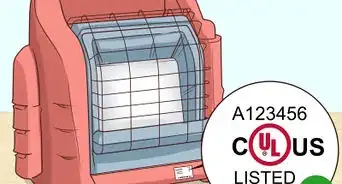

- Chapters
- descriptions off, selected
- captions settings, opens captions settings dialog
- captions off, selected
This is a modal window.
Beginning of dialog window. Escape will cancel and close the window.
End of dialog window.
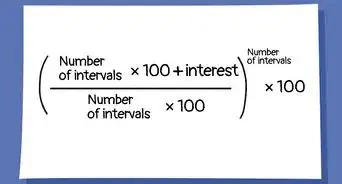 How to Find the Effective Interest Rate
How to Find the Effective Interest Rate

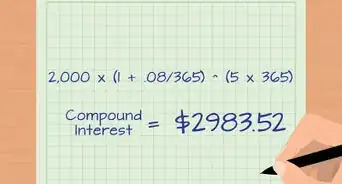
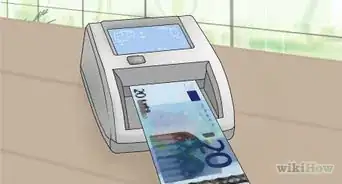
 Where Is My Wallet? How to Protect Your Money & Find a Misplaced Wallet
Where Is My Wallet? How to Protect Your Money & Find a Misplaced Wallet
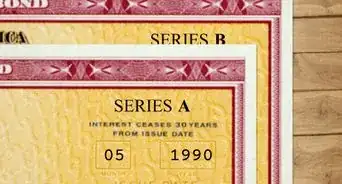 How to Check or Calculate the Value of Savings Bonds
How to Check or Calculate the Value of Savings Bonds
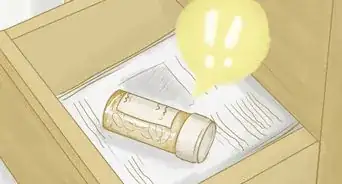

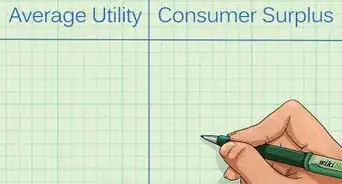
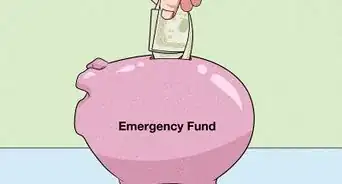 How to Keep Track of Your Money: Personal Finance Tips
How to Keep Track of Your Money: Personal Finance Tips
References
- ↑ https://meridiancoin.com/contemporary-fake-silver-dollar-guide/
- ↑ https://coinquest.com/cgi-bin/cq/coins.pl?coin=1048
- ↑ https://coins.thefuntimesguide.com/trade_dollars/
- ↑ https://tradedollar.org/composition-and-specifications/
- ↑ https://www.silver-coins.org/counterfeit/fake-coin-examples/1885-silver-trade-dollar.html
- ↑ https://meridiancoin.com/contemporary-fake-silver-dollar-guide/
- ↑ https://www.silver-coins.org/counterfeit/fake-coin-examples/1885-silver-trade-dollar.html
- ↑ https://meridiancoin.com/contemporary-fake-silver-dollar-guide/
- ↑ https://www.silver-coins.org/counterfeit/fake-coin-examples/1885-silver-trade-dollar.html
